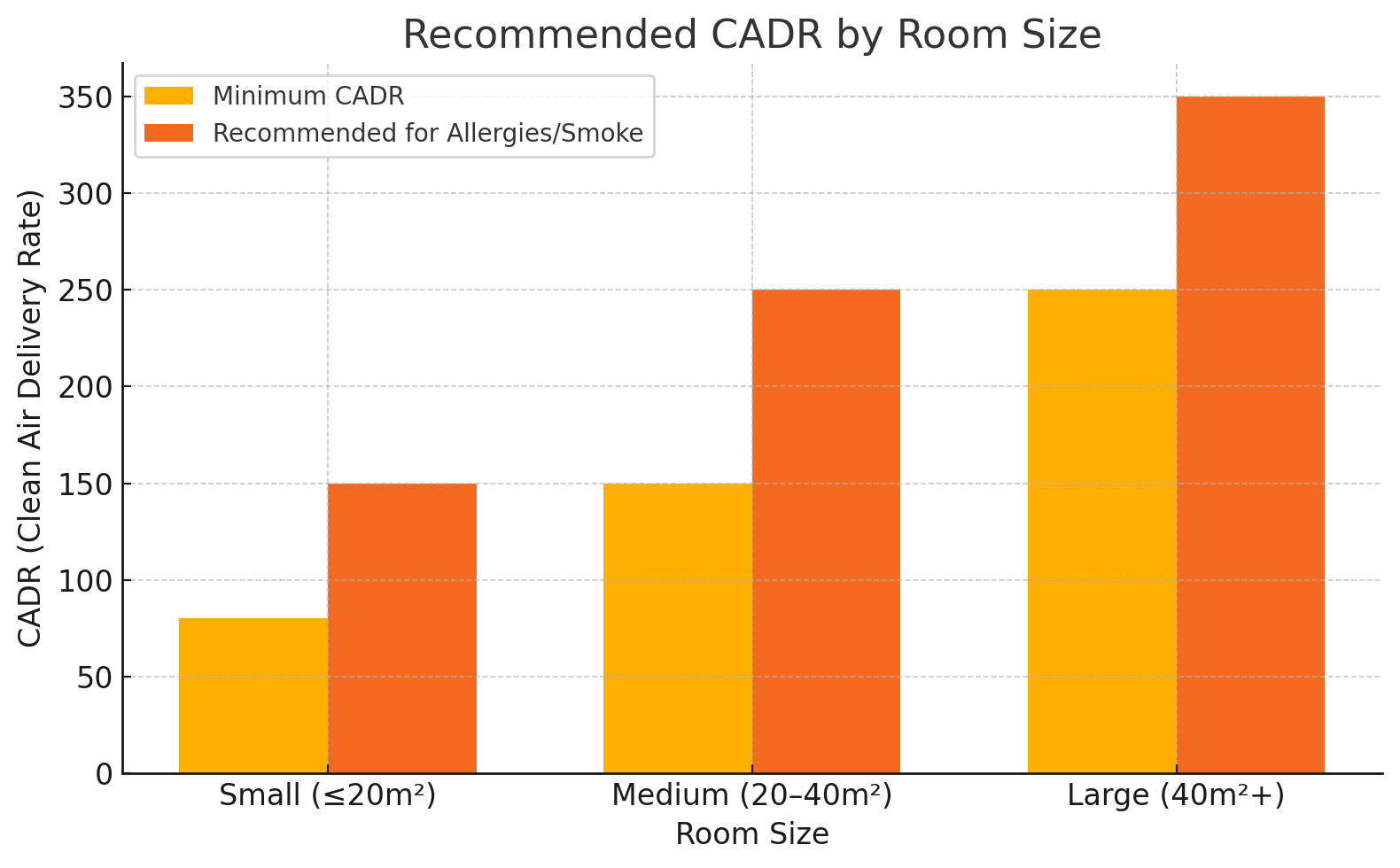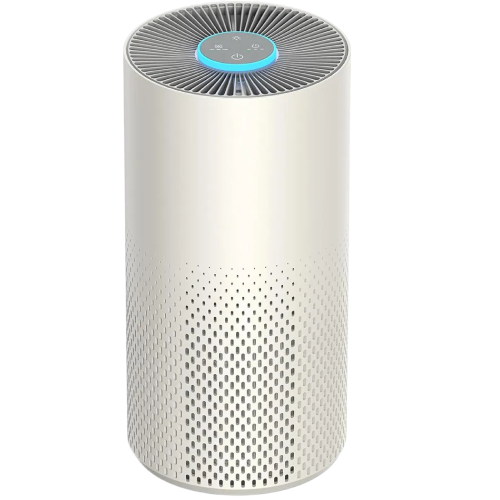An air purifier can significantly improve air quality in your home by removing pollutants, allergens and odours, helping to reduce symptoms of allergies and asthma. If smoke is a concern – whether from cooking, hobbies like wood-working and metal-working or outdoor pollution – look for a model designed to tackle it, typically combining a true HEPA filter with a high-quality activated carbon filter to absorb odours and gases.
There are air purifiers specifically designed for handling smoke, and in this guide we’ll explain the key benefits, review popular manufacturers and help you choose the right one for your needs.
Filter Type
The filter system is the most crucial part of any air purifier – and even more important if you’re looking for an air purifier to eliminate smoke. Many air purifiers come with multiple filters, and can often be labelled as hybrid models. The type and number of filters determine how well the unit can capture smoke, dust, allergens, and odours.
- Pre-filter: Captures large particles like hair and lint to protect the main filters and extend their lifespan.
- HEPA filter: Traps up to 99.97% of microscopic particles as small as 0.3 microns, including smoke, dust, and pollen.
- Activated carbon filter: Absorbs smoke odours, VOCs (volatile organic compounds), and other chemical pollutants.
- HEPA + Carbon combination: The most effective setup for smoke, offering both particle capture and odour removal.
- Ion filter (optional): Releases negatively charged ions that bind to airborne particles, helping them fall out of the air – though not essential for smoke removal.
- Ozone filter: Not typically recommended for indoor use due to potential respiratory irritation.
Always check whether replacement filters are easily available and priced reasonably before purchase.
Smoke & Odor Removal Performance
The performance of an air purifier is commonly rated using CADR (Clean Air Delivery Rate), measured in cubic metres per hour (m³/h). This indicates how effectively the purifier can remove smoke, dust, and other macro particles. It’s one of the most important aspects when choosing an air purifier. The following chart is a good way to find out what air purifier is suitable for your space:
For smoke-heavy environments, always choose a purifier rated for at least one size larger than your actual room.

Air Quality Sensor
Many modern purifiers include a built-in air quality sensor that continuously monitors the air and automatically adjusts fan speed.
- Yes: Automatically senses particle levels and adjusts performance in real time.
- No: Requires manual control, but can still perform effectively with consistent use.
Typical Modes & Functions
Air purifiers often come with preset modes that work for different use cases and lifestyles. Whether you have children and pets or need advanced modes to adapt to your schedule, look for:
- Auto mode: Adjusts fan speed automatically based on detected air quality.
- Sleep mode: Operates quietly at low speed with dimmed lights, perfect for nighttime use.
- Child lock: Prevents accidental setting changes by disabling the touch screen and buttons – ideal for families with children or pets.
- Fan-Only Mode: Purifier runs as a regular fan without activating filtering components (not always included, varies by model).
- Eco / Energy-Saving Mode: Reduces power consumption by lowering fan speeds when the air quality is already well balanced.
Filter Lifecycle
Filters need to be maintained or replaced regularly to maintain performance. Always check what filters your air purifier has and how often they will need replacing to avoid surprises later.
- Replaceable filters: Most HEPA and carbon filters need replacement every 6–12 months, depending on use.
- Washable filters: Some models include washable pre-filters or permanent HEPA layers.
- Both: Premium units may feature washable pre-filters combined with replaceable HEPA or carbon elements.
Noise Level (dB)
Noise is a key factor, especially if you plan to run your air purifier overnight, in your child’s bedroom or while you’re working. While most air purifiers are generally pretty quiet, there are noticeable differences in the noise levels, which often reflect on the price, too.
Maintenance Type
Air purifiers only work effectively when their filtration system is properly maintained. Over time, filters and collection components become saturated with dust, allergens, and pollutants. If left unchecked, airflow drops, efficiency declines, and trapped particles can even be released back into your home.
- No filters to replace: Some models use electrostatic plates to collect particles, reducing running costs.
- Wipe-clean collector plate: A reusable option that needs regular cleaning rather than replacement.
- Filter replacement: Most filters (except the basic plastic ones) need replacing regularly, depending on usage and air quality. Regular replacement ensures optimal performance and prevents trapped pollutants from being released back into the air.
Smart Connectivity (Wi-Fi, App)
Many modern air purifiers now offer Wi-Fi connectivity, allowing you to control them remotely through a smartphone app. Some models even support voice commands via Alexa or other smart assistants so that you can directly speak to your appliance without having to lift a finger.
Most common app functions include:
Energy Consumption
Whether you plan to run your air purifier 24/7 or not, energy use is an important factor as it directly affects how much money you spend on bills. If energy efficiency is important to you, check the unit’s consumption beforehand and compare shortlisted products to find the most efficient model. Eco modes or eco-labelled products are also a good choice.
Look for Energy Star-certified models for the best efficiency.
Light Indicators
Visual indicators make it easy to track air quality and filter status at a glance. The most common light options include:
- LED ring: Displays air quality via colour codes (e.g., green = clean, red = polluted).
- Digital display: Shows PM2.5 readings, modes, and timer settings.
- LED indicator only: Simple lights showing power or filter alerts.
- None: Basic models with manual control only.
Portability
If you need to move your purifier between rooms or take it with you on trips (for example, to a holiday home or when visiting family), consider its portability features:
- Wheels: Best for large or heavy models.
- Handles: Useful for compact units and easy repositioning.
Design, Size, and Colours
Air purifiers come in a variety of styles to match your interior decor and space layout. You can find air purifiers made of plastic and metal, as well as stylish units made from glass that will fit the most luxurious environments. Most modern purifiers are available in neutral finishes like white, grey, or black, though some brands offer stylish metallic or pastel options.
Certifications
Check for independent certifications to ensure your air purifier meets safety, performance, and environmental standards, and look for awards from reputable publications and journals.
- AHAM: Verifies CADR and room coverage.
- CADR rating: Indicates cleaning speed and capacity.
- Energy Star: Confirms energy efficiency.
- Quiet Mark: Recognises low-noise operation.
Dust Collection Bin
The dust collection bin is a key part of keeping your appliance operating effectively. As dust, debris, and allergens build up, they can restrict airflow and reduce performance. A well-designed bin makes it simple to remove this buildup before it causes problems.
- Tray: Easy to remove and empty.
- Bag: Disposable option for mess-free maintenance.
- Washable bin basket: Eco-friendly and reusable.
Leading Manufacturers Overview
Philips
Best for: Reliable Performance | Smart Sensors | Low Noise
Philips air purifiers are renowned for their smart sensors and energy efficiency. Many models feature VitaShield and AeraSense technologies that automatically detect and eliminate fine smoke particles.
Cons: Filters can be more expensive than third-party options.
Levoit
Best for: Budget-Friendly | Compact Rooms | Easy Operation
Levoit offers affordable yet powerful purifiers ideal for bedrooms and small living spaces. Their Core series models include True HEPA + Carbon filters, perfect for smoke and odour removal.
Cons: Smaller coverage area and no built-in air quality sensor in some models.
Blueair
Best for: Scandinavian Design | High CADR | Low Energy Use
Blueair’s HEPASilent™ technology combines mechanical and electrostatic filtration for ultra-efficient smoke removal with minimal noise.
Cons: Filters need regular replacement and are brand-specific.
Shark
Best for: Whole-Home Purification | Anti-Allergen Tech | Value for Money
Shark air purifiers use Clean Sense IQ technology to detect and respond to air changes instantly. Their models are well-suited for homes exposed to kitchen smoke or outdoor pollution.
Cons: Slightly higher energy use at max setting.
Dyson
Best for: Premium Design | Multi-Function Purification | Smart Features
Dyson purifiers combine HEPA H13 filtration, activated carbon, and air circulation technology in one elegant unit. Many models double as cooling fans and feature auto-sensing, app control, and voice commands.
Cons: High price point and premium filter replacements.





